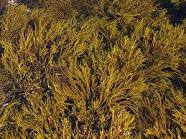Acne is an age-old problem for teenagers but help could be at hand from an unlikely source, according to a study.
An active ingredient from brown seaweed found only off the coast of Brittany, France, can cut spots by nearly two thirds.
Spots can affect people at any age. Many cases are mild, but for 15 per cent of the population about nine million people acne can be more severe.
Seaweed has been found to contain a powerful active ingredient that could help to beat acne.
The active ingredient is extracted out of the brown seaweed Laminaria digitata, which grows in dense patches on rocky sea floors at the tip of Brittany and is protected from pollution.
A new clinical trial of treatments containing the ingredient showed the number of spots fell by 64 per cent and blackheads by 60 per cent after just eight weeks.
The trial is the first cosmetics clinical study in acne to be published in an official dermatology journal.
The study investigated products from a range of OXY treatments using the active compound called Phycosaccharide ACP.
Oxy acne treatments in particular are designed to clean pores and reduce acne inflammation.
Phycosaccharide ACP, a marine plant extract from brown seaweed, regulates oil (sebum) production, removes and clears away P.acnes (acne-causing bacteria), and reduces redness.
They are mainly aimed at teenage boys and young men, with nine out of 10 suffering problem skin triggered by the male hormone testosterone.
One in four acne sufferers get some permanent scarring from the condition, yet surveys show almost half of those with problem skin do nothing to treat it, especially teenage boys.
Dr. Gill Jenkins, a GP with a special interest in acne, said the combination of seaweed extract and zinc directly affected the formation of spots, rather than the oil-producing sebaceous glands.
She said ‘The zinc-oligosaccharide complex used in this study produced a significant reduction in mild acne compared with control without causing irritation.
‘As a result of this study, I would suggest that for many people with mild acne, opting for these OXY products could be beneficial since they have been clinically proven.
In a trial of 60 young men aged 14 to 21 years with mild acne, half used seaweed-based skin wash and balm, while the others used dummy products that did not contain the active ingredient.
The trial found OXY products were significantly more effective than a dummy face wash, scrub or gel.
They cut the number of spots and problems areas as well as curbing inflammation and redness with improvement showing with 14 days.
At the end of the trial, after eight weeks, both groups of teenagers showed a reduction in inflammatory spots and comedones (blackheads and whiteheads).
But the effects were more statistically significant in the OXY group at two weeks, four weeks and eight weeks.
At the end of the study, OXY users had nearly twice the reduction of blackheads as the placebo group (60 per cent compared to 35 per cent) and significantly fewer spots (64 per cent reduction compared to 53 per cent).
Previous tests show a combination of zinc sulphate and Phycosaccharide ACP used in OXY products has a triple action against the three root causes of spots.
It has powerful antibacterial activity, controls oil by inhibiting the enzyme responsible for production and reduces redness and the acne bacterium was killed within one to 15 minutes.
The perfect marriage of science and technology brings dramatic improvements to the premature signs of aging and other face and body skincare concerns.
